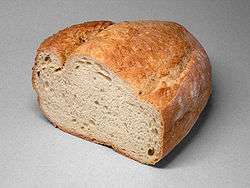Cozonac
|
Bulgarian Kozunak with raisins, braided and sprinkled with sugar. | |
| Alternative names | Bulgarian: козунак |
|---|---|
| Course | Dessert |
| Place of origin |
|
| Region or state |
Romania Moldova Bulgaria |
| Main ingredients |
Wheat flour Butter Milk Eggs Sugar Raisins Rahat Lemon zest Orange zest Walnuts Hazelnuts Vanilla Rum |
|
| |
Cozonac (Romanian pronunciation: [kozoˈnak]) or Kozunak (Bulgarian: козунак, Bulgarian pronunciation: [kozuˈnak]) is a traditional Romanian and Bulgarian sweet bread, which is a type of Stollen. It is usually prepared for Easter in Bulgaria, and mostly for every major holiday (Christmas, Easter, New Year's Day, Pentecost) in Romania and Moldova.
The dessert is also known as tsoureki (Greek: τσουρέκι), شوريك (Arabic), panarët (Arbërisht), choreg or chorek (Armenian: չորեկ), çörək (Azerbaijani), or çörek (Turkish). It is a sweet, egg-enriched bread, which is rooted in the cuisines of Western and Central Asia.[1] Such rich brioche-like breads are also traditional in many other countries, such as Hungary and the Czech Republic. Examples of similar breads from other cultures include badnji kruh in Croatian cuisine, folar de páscoa in Portuguese cuisine, brioche in French cuisine, kulich in Russian cuisine, panettone in Italian cuisine, and challah in Jewish cuisine.
Cozonac is a sweet bread, into which milk, eggs, sugar, butter, and other ingredients are mixed together before baking. In Bulgaria, the kozunak is prepared by adding lemon zest to the dough mixture, just as the Romanian version. The Italian Panettone is very similar to the basic cozonac, the most visible difference being their shapes.
In Romania, the recipes for trimmings differ rather significantly between regions. The dough is essentially similar throughout the country; a plain sweet bread made from flour, eggs, milk, butter, sugar and salt. Depending on the region, one may add to it any of the following: raisins, rahat, grated orange or lemon rind, walnuts or hazelnuts, and vanilla or rum flavor. Cozonac may be sprinkled with poppy seeds on top. Other styles dictate the use of a filling, usually a ground walnut mixture with ground poppy seeds, cocoa powder, rum essence, or raisins. The dough is rolled flat with a pin, the filling is spread and the whole is rolled back into a shape vaguely resembling a pinwheel. In the baked product, the filling forms a swirl adding to the character of the bread.
It was the sweet chosen to represent Romania in the Café Europe initiative of the Austrian presidency of the European Union, on Europe Day 2006.[2]
Origins
It is possible that the first cozonac has been made in Ancient Egypt. Perhaps it was sweetened with honey and filled with seeds. The Greeks took from the Egyptians their interest in cuisine, the yeast, and the leavened doughs. Certainly the Greeks have eaten cozonac. They made it with honey, raisins and walnuts. The Greek cozonac is called plakoús (πλακούς). Yeast and implicitly leavened breads, such as cozonac, were "stolen" from the Greeks by the Romans, where they added dried fruits to the cozonac. At first there were only two varieties called libum and placenta. Libum was a small cake, used as an offering to the gods. Later appeared versions were also consumed by people, not only by the gods. Placenta, more elaborate, is a cozonac made from cheese, raisins and peanuts, which was served with a sweet wine. Although, they took the ready-made yeast from the Greeks and the Egyptians, the Romans were the ones who discovered all the possibilities offered by the yeast added to doughs, thus becoming true masters of pastry. In the Middle Ages, European bakers often made cozonac with dried fruits, because they lasted longer.
In Great Britain, the first recipe of cozonac appears in a cookbook in 1718, with the recommendation to be baked in long and narrow forms, a recommendation that remains valid nowadays. The French people, those who in the 19th century added the third kind of meal, the dessert, are those who put forward the cozonac, more than others.
Today, this dessert with a long history is prepared mainly in the southeastern European countries, especially in Romania, Moldova and Bulgaria, where it is considered a traditional food.[3]
See also
Notes and references
- ↑ Толковìй словарь живаго великорусскаго язîка, Dal' V.I., IAS, 1869
- ↑ Coffee and Sweets
- ↑ (Romanian) "Istoria cozonacului", Revista Flacăra, December 10, 2010
External links
| Wikimedia Commons has media related to Cozonac. |
- Cozonac recipes and more
- Cozonac with walnut
- Cozonac
- Romanian Cozonac or Colac - a Christmas Bread, mislabeled cozonac but actually a Paskha recipe
- Cozonac Rosenkrantz
